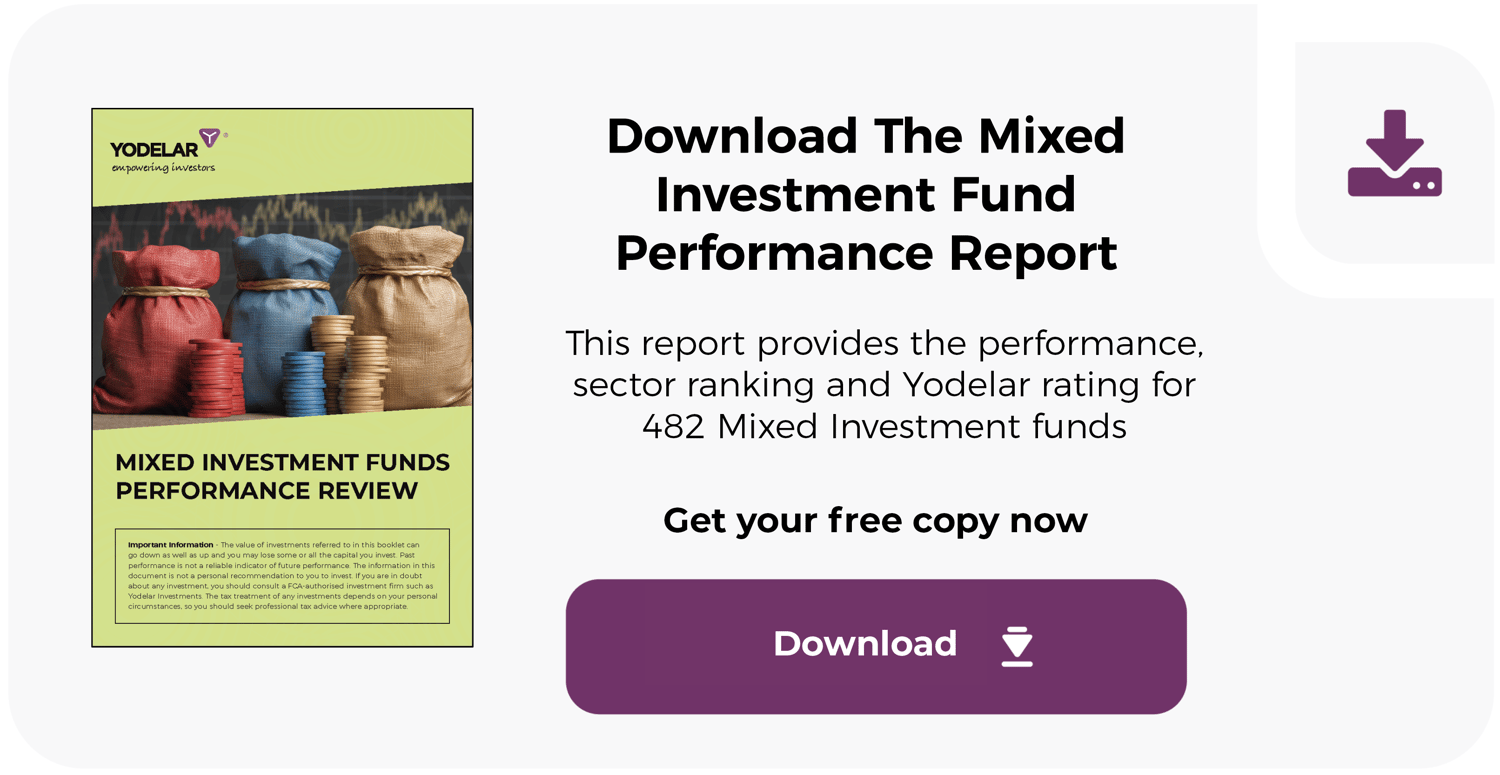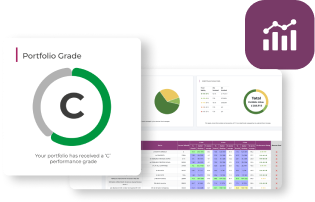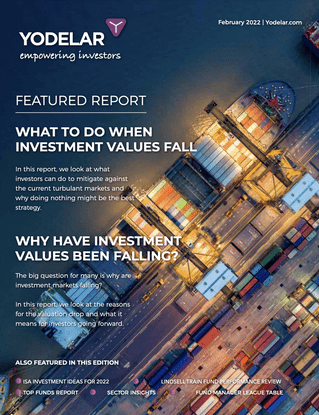-
A total of 482 mixed investment funds were analysed across the IA Mixed Investment 0–35%, 20–60%, and 40–85% Shares sectors.
-
Each fund was assessed over 1, 3, and 5-year periods, comparing returns and sector rankings to identify consistent performers.
-
Only 27 funds (5.6%) achieved a top Yodelar 5-star rating, while more than 60% underperformed relative to their sector averages.
-
The top 10 funds demonstrated consistent outperformance across multiple timeframes, ranking within the upper quartiles of their respective sectors.
-
Orbis Global Balanced Standard led all categories, delivering over 110% growth in 5 years — more than double its sector average.
Mixed investment funds remain a popular choice among UK investors seeking a balance between growth and stability. Designed to blend exposure across multiple asset classes — including equities, bonds, property, and cash — these funds cater to varying levels of risk appetite and investment objectives.
To help investors understand how these funds have performed in recent years, our latest analysis reviewed the performance of 482 mixed investment funds across the IA Mixed Investment 0–35% Shares, IA Mixed Investment 20–60% Shares, and IA Mixed Investment 40–85% Shares sectors. Each fund was assessed over 1, 3 and 5-year timeframes, comparing its returns and consistency against its respective sector averages.
This comprehensive study highlights 10 of the best performing funds that have achieved superior results relative to their peers, demonstrating strong performance trends and consistent sector rankings over multiple periods.
The full report — detailing performance data, sector averages, and ratings for all 482 funds — is available to download throughout this article. It provides investors with a complete view of how each fund compares within its category, supporting a clearer understanding of the mixed investment landscape and the performance dispersion across risk levels.
Mixed Investment Funds Performance Summary
Our analysis of 482 funds across the three IA Mixed Investment sectors found a clear divide in results. Only 27 funds (5.6%) achieved a top 5-star Yodelar rating, consistently ranking among the best in their sectors over 1, 3 and 5 years. A further 54 funds (11.2%) earned 4 stars for above-average performance.

In contrast, over 63% of all funds rated 1 or 2 stars, indicating performance below their sector averages. This highlights how outcomes can vary widely, even among funds with similar risk profiles. While all mixed investment funds combine equities with other assets, only a small minority have managed to deliver strong, consistent returns across different market cycles
Understanding the IA Mixed Investment Sectors
The IA Mixed Investment sectors group together funds that blend equities with other asset types such as bonds, property, and cash. This structure allows investors to choose funds that align with their tolerance for risk and desired balance between growth potential and capital stability.
The IA Mixed Investment 0–35% Shares sector contains funds that take a more cautious approach, with the majority of holdings in bonds and cash. Equity exposure is capped at 35%, which helps to reduce volatility but limits potential growth. These funds are typically positioned at the lower end of the risk spectrum, aiming to deliver steadier returns through broad diversification.
The IA Mixed Investment 20–60% Shares sector represents a middle ground between defensive and growth-oriented strategies. Funds in this category invest between 20% and 60% in equities, combining growth assets with lower-risk holdings such as bonds. This flexibility allows managers to adjust allocations in response to changing market conditions, aiming to achieve a more balanced outcome over time.
The IA Mixed Investment 40–85% Shares sector includes funds that lean more heavily towards equities, with exposure ranging from 40% to 85%. This higher weighting makes them more sensitive to market movements but offers greater potential for long-term capital growth. These funds typically sit at the upper end of the mixed investment risk range.
Unlike single-asset sectors such as IA Global or IA Emerging Markets, which focus solely on equities within specific markets, the mixed investment sectors include multi-asset strategies. This diversification means performance is influenced by a combination of asset classes rather than a single market, leading to differing levels of volatility and consistency across the three mixed investment categories.
Together, these sectors provide a structured view of how fund managers balance opportunity and risk, making them a useful reference point for understanding how diversification impacts overall portfolio performance.
10 Top Performing Mixed Investment Funds
From cautious to growth-focused strategies, the mixed investment universe offers a broad range of approaches that balance equities, bonds, and other assets to meet different risk objectives. To identify which funds have delivered the most competitive results, we analysed 482 mixed investment funds across the IA Mixed Investment 0–35% Shares, IA Mixed Investment 20–60% Shares, and IA Mixed Investment 40–85% Shares sectors.


Each fund’s performance was assessed over 1, 3, and 5-year periods, comparing total returns and sector rankings against peers within the same category. The analysis highlights 10 funds that have achieved strong and consistent results over multiple timeframes, often outperforming their sector averages by a significant margin.
Jupiter Merlin Monthly Income Select Fund
This fund, from the IA Mixed Investment 0–35% Shares sector, has performed consistently well over time. It achieved growth of 8.45% over 1 year, ranking 4th of 69 funds, and remained competitive with returns of 21.92% over 3 years and 18.65% over 5 years, both above the sector averages of 5.47%, 18.22%, and 14.77% respectively. Managed by Jupiter’s Independent Funds Team, it invests mainly in other collective investment schemes, blending income and capital growth strategies with a bias towards fixed income. The fund’s OCF of 0.63% is relatively modest for an actively managed multi-asset fund, and its steady performance has been supported by strong management continuity and diversified underlying holdings.
True Potential Schroder Cautious Fund
Also within the cautious 0–35% sector, this fund was the top performer across all measured periods. It delivered 11.21% over 1 year, 33.70% over 3 years, and 57.47% over 5 years, outperforming sector averages of 5.47%, 18.22%, and 14.77%, ranking 1st in each timeframe. The fund combines exposure to equities and bonds while maintaining a cautious allocation that has nevertheless captured strong upside during market recovery phases. Its OCF of 1.16% is higher than average but reflects its use of multiple underlying Schroder funds and an active asset allocation approach. Despite a cautious mandate, the fund has produced growth more typical of higher-risk sectors over the longer term.
L&G Mixed Investment Income 0–35% Fund
The L&G Mixed Investment Income fund ranked 13th of 69 over 1 year, 3rd of 65 over 3 years, and 5th of 58 over 5 years. Its returns of 6.89%, 27.51%, and 22.59% comfortably exceeded the sector averages of 5.47%, 18.22%, and 14.77%. The fund follows a cost-efficient multi-asset strategy that combines UK and global exposure through index-tracking components, giving investors a diversified mix at low cost. With an OCF of just 0.41%, it ranks among the cheapest in its category. Its strong mid-term performance highlights the advantage of disciplined rebalancing and broad diversification, particularly during periods of market fluctuation.
Orbis Global Cautious Standard
In the IA Mixed Investment 20–60% Shares sector, Orbis Global Cautious Standard achieved standout results. It delivered 11.40% over 1 year, ranking 3rd of 190, 33.76% over 3 years, ranking 5th of 171, and 56.02% over 5 years, ranking 2nd of 156 — all well ahead of the sector averages of 7.09%, 22.53%, and 27.70%. The fund invests globally across equities, government bonds and commodities, applying a flexible and cautious allocation. Notably, Orbis operates a unique fee model, where investors receive a performance fee refund if the fund subsequently underperforms. Its OCF of 1.20% (excluding performance adjustments) places it mid-range, yet its consistent outperformance demonstrates the value of its active, research-driven approach.
Schroder MM Diversity Z Fund
This fund has shown consistent growth within the 20–60% sector, delivering 10.43% over 1 year, 30.56% over 3 years, and 53.70% over 5 years, outperforming the sector averages of 7.09%, 22.53%, and 27.70%. Ranking 10th, 9th, and 3rd over these periods respectively, the fund invests across a wide spread of assets and regions through Schroder’s multi-manager structure. Its OCF of 1.18% reflects the layered nature of its holdings but remains justified by its track record of steady long-term growth. The portfolio’s focus on inflation-adjusted outcomes and global diversification has helped maintain strong returns even in varied market conditions.
Invesco Global Income (UK) Z Fund
Also in the 20–60% sector, this fund combines equities and bonds to achieve both income and growth. It recorded 9.26% over 1 year, 43.17% over 3 years, and 52.49% over 5 years, ranking 25th, 4th, and 6th in its sector. All periods outperform the averages of 7.09%, 22.53%, and 27.70%. With around 40% in equities and the remainder in investment-grade and high-yield bonds, the portfolio benefits from a balance of risk and income generation. Its OCF of 1.54% is on the higher side but reflects the active management required to dynamically shift allocations across global markets and credit grades.
Orbis Global Balanced Standard
In the higher-equity IA Mixed Investment 40–85% Shares sector, Orbis Global Balanced Standard led performance across all timeframes. It achieved 23.81% over 1 year, 60.41% over 3 years, and 110.54% over 5 years, compared to sector averages of 9.28%, 28.38%, and 40.81%, ranking 1st, 1st, and 1st respectively. The fund blends global equities, bonds, and commodities within a flexible structure that adapts to market conditions. Its strong performance has been driven by concentrated but diversified exposure to global growth assets. While the fund’s OCF is effectively nil under its fee-refund model, investors should note that variable performance charges apply depending on returns achieved.
IFSL Wise Multi-Asset Income B Fund
This fund also sits within the 40–85% sector and has produced high levels of growth alongside a focus on income generation. It delivered 13.43% over 1 year, 34.55% over 3 years, and 94.61% over 5 years, ranking 15th, 7th, and 2nd of 223, again outperforming the sector averages of 9.28%, 28.38%, and 40.81%. The portfolio invests across equities, infrastructure, property, and fixed income, adopting a value-based approach that seeks resilient income streams. With an OCF of 0.93%, it remains competitively priced for an actively managed, income-targeted multi-asset fund.
Invesco Global Balanced Index (UK) No Trail Fund
This index-based fund achieved 15.84% over 1 year, 47.05% over 3 years, and 79.39% over 5 years, outperforming the sector averages of 9.28%, 28.38%, and 40.81%, and ranking 3rd, 4th, and 3rd of 223. The fund follows a systematic factor-based approach, targeting value, quality and momentum within a globally diversified mix of equities and bonds. Its transparent, disciplined methodology has helped deliver strong long-term returns with controlled risk. The fund’s OCF of 0.45% is notably low, underscoring its cost-efficient structure relative to actively managed peers.
Credo Dynamic A Retail Fund
Credo’s multi-asset Dynamic fund achieved 14.95% over 1 year, 36.19% over 3 years, and 66.80% over 5 years, ranking 7th, 5th, and 9th out of 223. Each period comfortably outperformed the 40–85% sector averages of 9.28%, 28.38%, and 40.81%. The fund blends global equities, fixed income and alternative assets with a bias towards UK holdings and selective international exposure. Its pragmatic, flexible allocation has helped smooth volatility while participating in equity market growth. The fund’s OCF of 0.75% is mid-range, and its consistent ranking highlights effective risk management and steady performance across market cycles.
Summary
This report analysed 482 mixed investment funds across the IA Mixed Investment 0–35% Shares, 20–60% Shares, and 40–85% Shares sectors to identify the funds that have delivered the most competitive and consistent results over 1, 3, and 5-year periods.
The findings reveal that only a small proportion of funds within each sector have outperformed their peers and maintained top-quartile rankings across multiple timeframes. Among them, ten funds stood out for their ability to combine steady, risk-adjusted returns with consistent sector leadership — including strong performers from Jupiter, Orbis, Invesco, L&G, and Schroder.
The analysis highlights the significant variation in outcomes, even among funds with similar risk mandates. It reinforces the value of diversification and continuous oversight in achieving sustainable long-term results. While past performance is not indicative of future returns, understanding these trends helps investors identify where fund strategies have proven most resilient and where greater balance and professional management can add lasting value.
The Importance of Active Diversification and Ongoing Oversight
The varied results across the 482 mixed investment funds analysed highlight an important truth: performance consistency is rare, even within similar risk categories. Some funds have adapted well to shifting market conditions, while others have struggled to keep pace. These differences underline the importance of structure and oversight in how portfolios are built and maintained.
Diversification across sectors, regions, and fund managers helps to smooth out the uneven effects of market cycles. It reduces reliance on any single investment style or strategy and creates a broader foundation for long-term growth. But diversification alone is not enough. Portfolios must also be actively monitored and adjusted as markets evolve — ensuring the original balance of risk and opportunity remains intact.
Professional oversight, such as that provided through MKC Invest’s discretionary management, plays a critical role in this process. By continually analysing performance, assessing risk alignment, and making timely adjustments, discretionary management keeps portfolios efficient and responsive. In a landscape where even the strongest funds can fall in and out of favour, disciplined portfolio management and genuine diversification remain key to achieving stable, long-term outcomes for investors.

















